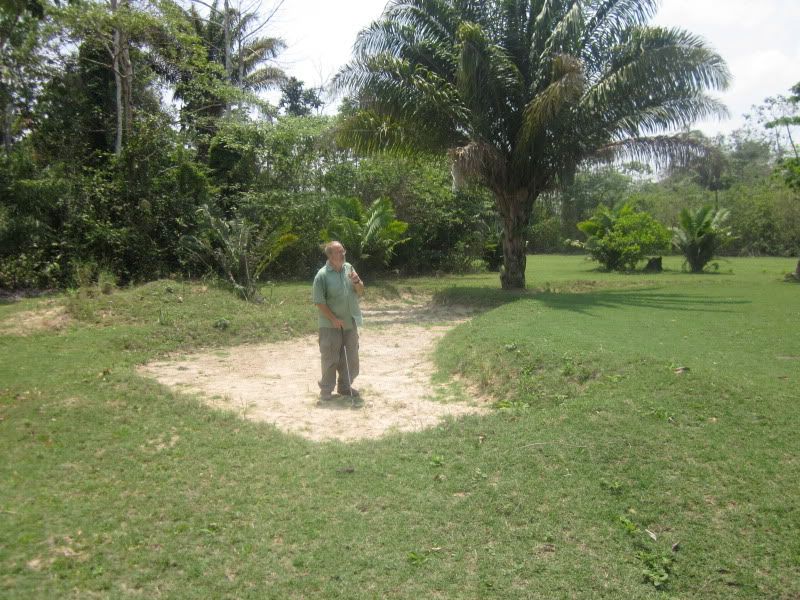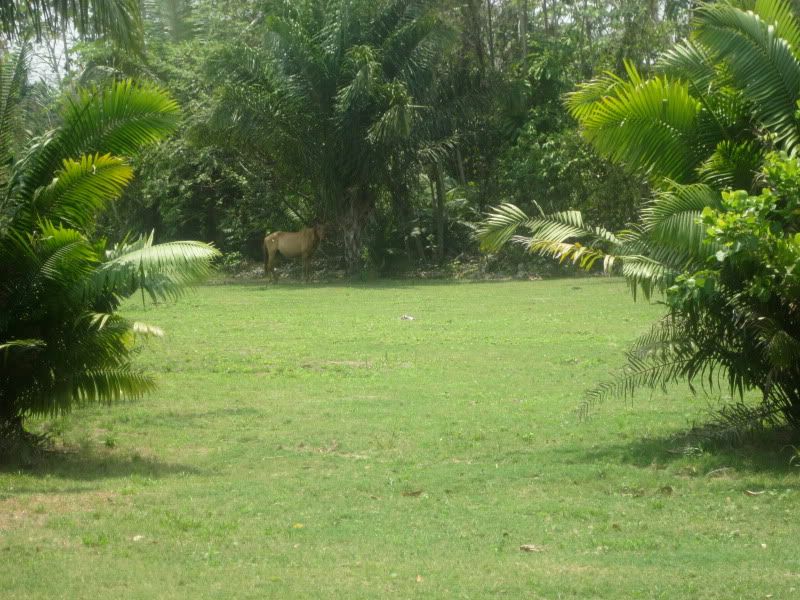After spending a day with an indigenous community that runs an eco-tourism operation on the sixth day of the trip, Day Seven was a reality check. We visited Daniel Robison's farm and learned about what he is doing to try to "save the rainforest" and what his neighbors are doing, which - in some cases - is not so good. This diary is about a strange attempt to help the Amazon by building a golf course there.
My trip was organized by Global Exchange and Food First. You can find out about future Food Sovereignty tours at the link.
After showing us his farm, Daniel took us to a place he only referred to as his "other property." This property is 100 hectares and it backs up to the Pilon Lajas Biosphere Reserve, which is 400,000 hectares. Daniel asked us to guess what this property was for.
Well, if we are guessing, then it's probably not another farm, right? And he had already said that there are horses here. I was stumped. Then Daniel took out a golf club and pretended to swing it at a golf ball. A golf course? In the rainforest? Created by an environmentalist who is an expert in agroecology and soil science? Could it be???

Daniel, with a golf club
Then Daniel told us his plan. He wants to make this the most biodiverse golf course in the world. And - before we make judgments about it - he explained that the holes are separated by areas of forest, creating a lot of surface area of "edge," which wildlife loves. I know from my previous experiences in agriculture that the "edge effect" can be very helpful to agricultural productivity - edge in that case being the edge between the field and the uncultivated area next to it. In Daniel's case, edge meant the border between the forest and the wide open spaces on the golf course.

The horses, which double as lawnmowers
Daniel went on to tell about the animals he's already observed on this golf course. "From Argentina to Mexico there are a possible 6 wildcat species. We have 4 on our property," he said. I've looked it up and that might be a slight over-simplification, because there are a few more than 6 wild cats in South America, but some have small ranges or ranges that don't extend into this part of Bolivia. The cats that live in this part of Bolivia are, to the best of my knowledge: pumas, jaguars, jaguarundis, margays, ocelots, and pampas cats. Of those, Daniel and his staff have observed the jaguar, ocelot, jaguarundi, and "a smaller jaguarundi type of cat" (I have no idea what that might be) on this property.
Daniel went on to describe his plans. In addition to golf, he plans to offer horseback riding, bird watching, and hiking trails. "Bird watchers come here and they just drool," he said. "At five in the afternoon, this place is full of toucans." He also mentioned sitings of wild turkeys and macaws. He's been in consultation with birding experts, who encouraged him to have parts of the property in all different stages of succession, and to leave the dead trees in the forest to encourage a maximum biodiversity of birds. The caddies, Daniel said, won't be your typical caddies. They will be experts on the forest, pointing out interesting species to the golfers as they go.
"Do golfers actually come here?" we asked. After all, Rurrenabaque seems to be the type of tourist destination that attracts mostly young backpackers, not rich golfers. Daniel responded that his golf course is not open yet, but they are on the brink of opening the first holes. This golf course is an hour's flight from the world's highest golf course (in La Paz) so an adventurous golfer could easily visit both on the same trip.
So far so good, but really, what is a self-proclaimed agroecologist doing opening a golf course? Daniel explained that there are limited economic possibilities around here for agriculture, largely because families are willing to exploit free family labor, thus making it impossible for anyone to compete who is willing to pay a living wage. But tourism - that's where he sees promise.
With the rise of tourism, Daniel's seen an influx of local foods for sale here in Rurrenabaque. In the past, he said, it was impossible to buy local foods, even though the fruit is quite literally falling off the trees. If you go elsewhere in the Bolivian Amazon, areas without tourists, you'll still see that the food gets shipped in from La Paz. Yet now, people see a way to profit by selling fresh squeezed tropical juices, (relatively) local coffee (it's produced near here, but not here, because the elevation is too low), local chocolate, etc.
Daniel also appreciates the tourism because it is creating a demand for indigenous knowledge. Bolivia has a long history of racism and exploitation of its indigenous majority. In fact, Daniel even told us of one entire culture that was entirely wiped out, not via a planned genocide, but just because the people were simply worked to death. But now, the tourists show up and they are looking for the people who speak the indigenous languages, who are in touch with the indigenous culture, and who have the in depth knowledge of the forest that the indigenous communities here have (knowledge that Daniel says is being lost in his lifetime). That's a big deal.
I'd like to add that while I believe Daniel when he speaks of the vast improvement in locally produced foods and other goods now available here, you can see in my initial diary about Rurrenabaque that the entire town resembles a dollar store. There are many, MANY places to buy cheap crap, and only a few that I found where you can buy locally made handicrafts. I also found a few shops that served tropical fruit juices, including one called Cafe de la Jungla that sells fair trade organic coffee that was grown nearby and serves local, wild chocolate.
As for his own golf course, Daniel says that this land would support four families at poverty level if it were used for slash and burn agriculture. He plans to support 10 families with a living wage with his golf course. I certainly hope that is the case. And I am also encouraged by the successes of San Miguel del Bala and other eco-tourism operators like the Chalalan Ecolodge. I don't believe that all tourism operations will be as committed as Daniel to paying a living wage, and there are also legitimate concerns about exploitation of wildlife by tourism operations. But it does seem that this golf course, at least, is something good.
No comments:
Post a Comment